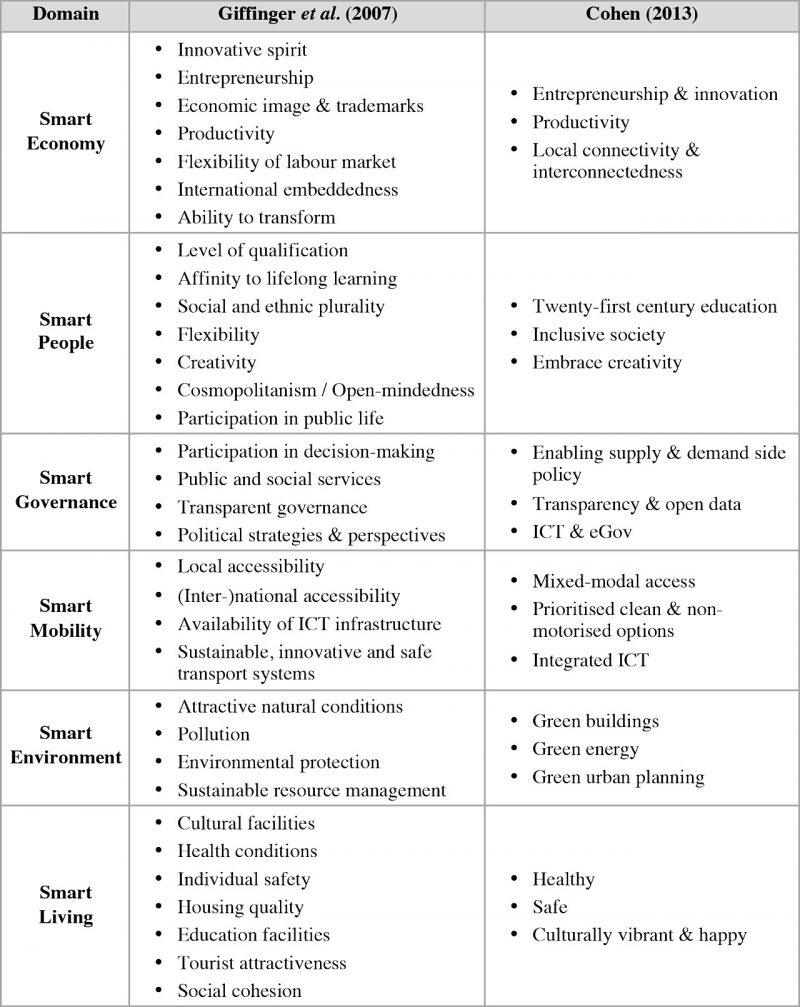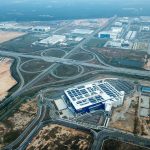Executive Summary
- Urban dwellers in Malaysia are projected to make up 87% of the country’s population by 2050. This means that cities, including secondary ones like Penang, will need to be “Smart” if they are to handle the challenges this rise in the urban population presents
- Public Transportation, Green Buildings and Disaster Management are among the suggested key areas where Penang can aim to become a state with Smart Mobility, Smart Economy, Smart Environment and Smart Community
- The state government will have to foster data-driven and data-proficient governance and build Smart City infrastructure if it is to realise its vision of Penang being a Family-focused Green and Smart State
Introduction
By 2050 the world’s urban population will have increased to 70% (United Nations, 2018). With the rapid growth in urban population, cities around the world are facing a wide range of persistent issues and challenges in delivering urban services. One popularly proposed approach for meeting this challenge is for city planners and governments to create “Smart Cities”.
The model and development of a Smart City varies from place to place, depending on local needs and available resources. There is still no universally standardised single definition for Smart City, but in brief, the concept can be understood as an urban area that efficiently utilises information and communications technology (ICT) to enhance its city functions and to improve the quality of life of its citizens.
As suggested in 2007, a Smart City has six key domains, namely Smart Economy, Smart People, Smart Governance, Smart Mobility, Smart Environment, and Smart Living; and that the assessment of a city’s performance as a Smart City can be done through a total of 33 factors (Giffinger et al., 2007). Later, this concept was further developed into a model known as the “Smart City Wheel” by Boyd Cohen (2013), who identified 18 key working areas based on the aforementioned six key domains, as simpler assessment criteria. (See Table 1 for details) The six key domains remain a guideline, although different cities in the world today project different priority areas based on local conditions.
Table 1: A Comparison of Giffinger’s and Cohen’s Concepts
Most city governments understand that they “must now comprehend the profound technological advances that have emerged in ICT, including the Internet of Things (IoT), machine to machine (M2M), and big-data analytics” (Stimmel, 2016). These technologies, also known as Smart City technologies, are now widely utilised around the world to manage and deliver urban services.
Table 2 shows the roles of the different actors and the systems needed for effective implementation of Smart City technologies.
Table 2: Selected Smart City Technologies
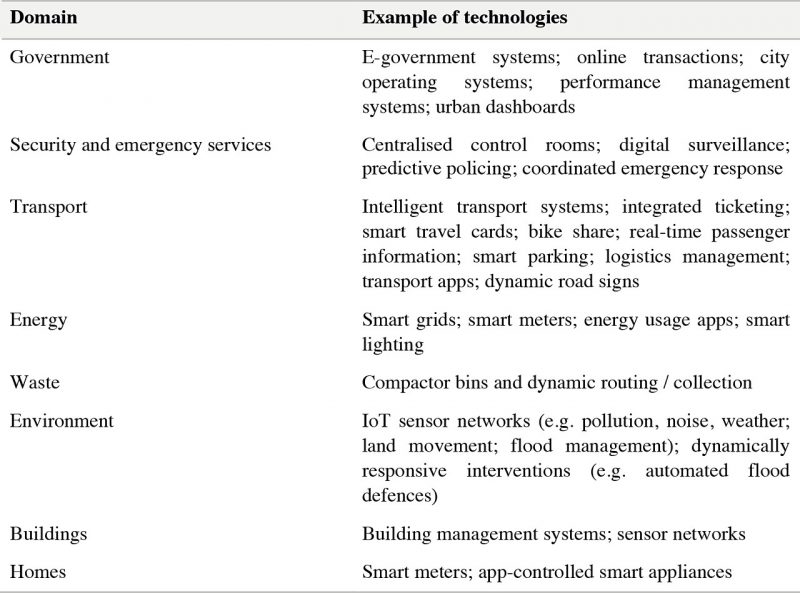
The Urban Population in Malaysia
Urban dwellers in Malaysia have increased tremendously in proportion to the rest of the country’s population – from 20% in 1950 to 76% in 2018. (See Figure 1) Notably, the percentage of urban population in Malaysia has already exceeded the percentage in the world as well as those in South-east Asia, Asia and Africa since 1980.
By 2050 this figure is projected to reach 87%, which will be 19% more than the corresponding figure for the world as a whole, and 21% more than for Asia and South-east Asia. This projection clearly illustrates that Malaysia is experiencing rapid urbanisation and is actively developing the concept of Smart City to tackle the increasing urban challenges.
Figure 1: Percentage of Population in Urban Areas from 1950 to 2050
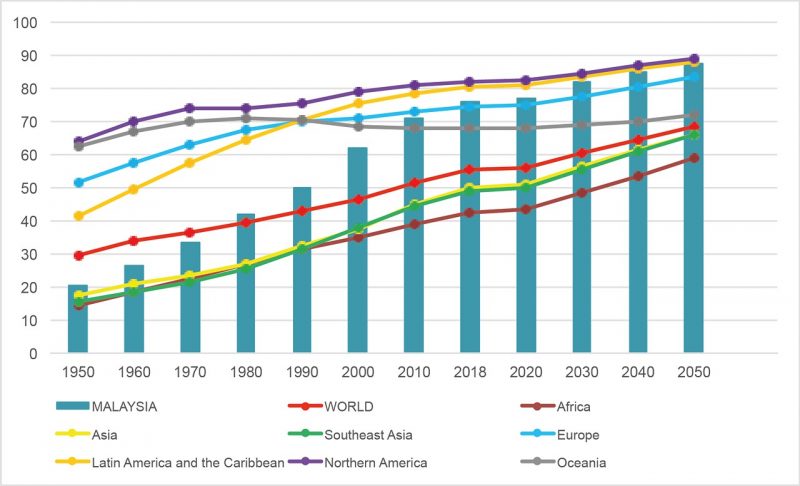
The Smart Cities in Malaysia
In Malaysia the notion of Smart City has served as a key component in the formulation of public policies. The federal government specifically emphasised the development of Smart Cities in its Eleventh Malaysia Plan (2016-2020), highlighting the challenges of dealing with large populations in cities as “pain points”. These include congestion; pollution; inefficient deployment of public services; and stresses on transport systems. The Plan underlines Smart Cities as the solution, citing it as “a next generation approach to urban management with solutions that address these issues and improve the quality of life of urban dwellers”.
The centrality to Malaysian development of Smart Cities also means that development will take place at the sub-national level, and different targets will be chosen and prioritised by policy-makers, depending on local needs.
One example is that of Smart City Iskandar Malaysia which was launched and endorsed by the federal government on November 1, 2012. This project identified six areas to be prioritised – Smart Economy, Smart Governance, Smart Environment, Smart Mobility, Smart People, and Smart Living.
There is also a strong tendency for state governments to include state development within this Smart City axis. For example, the state government of Selangor launched Smart Selangor in 2016 to transform Selangor into a Smart State by 2025. Twelve areas have been identified for this purpose – Smart Governance, Smart Digital Infrastructure, Smart Transportation & Mobility, Smart Waste Management, Smart Healthcare & Wellbeing, Smart Education, Smart Water Management, Smart Energy & Utility, Smart Food & Agro, Smart Safety & Security, Smart Buildings, and Smart Disaster Management.
What is interesting to note is that Smart City Iskandar Malaysia and Smart Selangor prioritise their areas differently. The six areas outlined under Smart City Iskandar Malaysia are close to the model developed by Giffinger or Cohen. Smart Selangor, however, takes a different approach by modifying its prioritised areas into twelve domains.
Penang Moving Towards a Smart State
Penang has also embraced the concept of Smart City, and is also looking at its own transformation into a Smart State by 2030. The notions of Smart City and Smart State do not vary that much in this context as the main ideas are on improving the livelihood of the people in Penang.
Aiming at enhancing the liveability, economy, civic participation, and balanced development in Penang, the state government launched its vision of Penang2030: A Family-focused Green and Smart State that Inspires the Nation in August 2018. Concurrently, the Penang Structure Plan 2030 – pending to be gazetted – also focuses on Penang becoming a smart and harmonious hub, marking it to international standards.
Among the key areas that the state government can look into include, but are not limited to, public transportation, green buildings and disaster management. These are suggestions that can be prioritised for the beginning phase of Penang’s transformation into a Smart State.
Public Transportation
Rapid Penang – as the primary public bus operator within the state – will need to go Smart by enhancing passenger experience, in particular, by providing real-time trip planning possibilities for the public. The “Penang Intelligent Traffic and Transport System” (PiTTS) introduced by the state government allows the public to search for buses and plan their trips through the mobile application. However, its “Where’s My Bus” function can still be improved on. Besides, PiTTS can only be used for its “Search & Routing” function similar to the one already provided by Google Maps.
Potential upgrades to the app should include the provision of real-time information, such as that enabling users to track the movements of buses in real-time, their arrival times as well as to calculate exact bus fares. The app can similarly notify users of real-time traffic conditions, e.g. if the buses are caught in bumper-to-bumper traffic or involved in an accident. Overall, this helps in promoting Penang’s vision of Smart Mobility. As pointed out by McKinsey Global Institute (2018), the average commuter could save 15 to 30 minutes in cities that utilise the applications of Smart Mobility.
On the other hand, the “Touch ‘n Go” card is already widely used for public transport in KL, be this on the Light Rail Transit (LRT), Mass Rapid Transit (MRT), Monorail, Bus Rapid Transit (BRT) or RapidKL buses. However, there are limitations to the nationwide use of the card.
Presently, Touch ‘n Go cards that are accessible on RapidKL buses cannot be used for Rapid Penang even though both bus services are owned and operated by the same company – Prasarana Malaysia. In Penang citizens and tourists pay cash when boarding the Rapid buses. This is far from ideal, especially when passengers have to provide the exact change when boarding. However, this can be counteracted with the purchase of Rapid Travel Cards for use on Rapid Penang buses.
A more seamless use of Touch ‘n Go will naturally make for more convenient travel in Penang, KL, and across the country, and for all citizens and visitors. It would certainly help Penang to realise the Smart International State it is aspiring for.
The percentage of internet users in Malaysia is recorded at 87.4%; 93.1% of them use the smartphone for online access (Malaysian Communications and Multimedia Commission, 2018). Based on this situation, a mobile app can be developed as an alternative mode for promoting cashless public transportation in the near future. This app will allow the public to reload money in advance, which can be scanned when boarding different modes of public transportation in Penang. The app can also be integrated with the RapidKL system, allowing the 2Cs (“Cashless” and “Cardless”) to be incorporated in reality, thus creating a mutually supportive environment that promotes the Smart Economy concept for Penang.
Green Buildings
The state government is also aiming to make Penang “Green” by promoting Green buildings. To achieve this goal, a conceptual combination of Green and Smart is helpful. A building is considered Green if it follows the Green Building Index (GBI) and is certified by the GBI rating system according to six key elements – energy efficiency; materials and resources; water efficiency; indoor environment quality; sustainable site planning and management; and innovation.
According to GBI (2019), the federal territory of KL has the highest number of GBI-certified projects at 177. Selangor ranks second at 154, in January 2019, while Penang comes in a far third at 44. Figure 2 illustrates the recent and steady growth of GBI projects in the state. Projects registered under GBI in Penang witnessed a three-fold growth between 2013 and 2019, going from 31 projects to 91. However, the percentage of these succeeding in obtaining GBI certification per year has not grown impressively. In January 2019, only 48% of registered projects have gained the desired status.
Figure 2: GBI Projects in Penang from 2013 until 2019
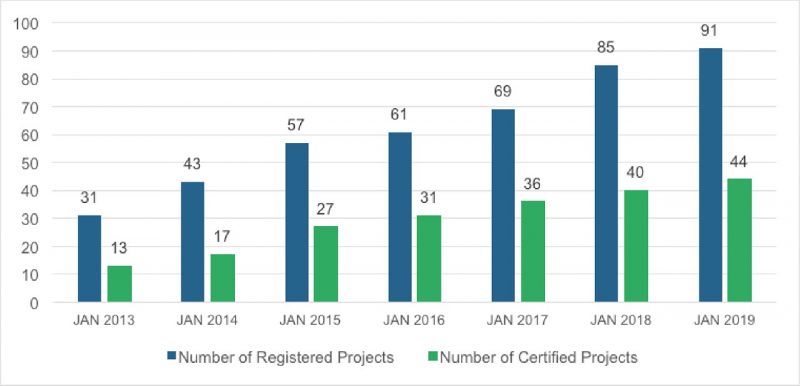
Aligning with its Penang2030 vision to make the state Green and Smart, it is important for the Penang state government to promote the adoption of GBI in both residential and commercial buildings. Green buildings can be further enhanced with Smart City technologies. Making buildings Smart and Green means that utilities such as energy and water can be effectively monitored and controlled through Smart City technology applications which will allow users to minimise energy wastage.
Greenhouse gas emissions can be decreased by almost 3% if building automation systems are adopted in most commercial buildings, and by an additional 3% if adopted in homes (McKinsey Global Institute, 2018). In having the building automation systems installed, energy and water consumption can be optimised through sensors and analytics.
In addition, temperatures in the home can also be remotely controlled and programmed, making it possible for the effective monitoring of energy consumption. For example, 15% of the energy required for cooling can be saved by using the application of Smart thermostats (McKinsey Center for Government, 2018).
Smart City technologies will lead to individuals accessing their own real-time energy usage patterns – for example on electricity and water. This will motivate them to reduce costs and, taken collectively, will develop Penang towards a Family-focused Green and Smart State, and facilitate in achieving a Smart Environment where the Green and Smart combination empowers a sustainable environment and improves environmental quality. A concerted push for this will make a substantial impact throughout the state.
Disaster Management
In responding to flood occurrences in Penang, several initiatives have been taken by main bodies such as the Penang State Department of Irrigation and Drainage (JPS), the City Council of Penang Island (MBPP), and the Seberang Perai Municipal Council (MPSP). Under the JPS, there are 25 siren stations in Penang – 11 on the Island and 14 on the Mainland – built around areas prone to flooding. Water-level sensors have been installed by MBPP in 10 flood-prone areas, while another 12 units of water-level monitoring and alert warning systems have been installed by MPSP in areas with pump houses.
However, these three initiatives can be upgraded with Smart features, such as alert messages which will be automatically delivered to the authority by siren stations or sensors whenever any part of them is experiencing malfunction or damage. Particularly for siren stations, this Smart feature is important in ensuring they are well-maintained and in functioning condition, and in saving time and human resources.
Currently, these initiatives require the public to visit different websites to obtain information on floods, such as JPS’s publicinfobanjir and MBPP’s official website. But there is a gap – there is no information on water levels in Seberang Perai. To foster better disaster management, the state government could consider integrating all information on flooding or potential floods onto a single website. JPS’s, MBPP’s, and MPSP’s online information could be synced to one source providing real-time data on water levels.
A smart app on disaster management can also be developed for easy public access. The real-time location of users should be automatically identified by the smart app for real-time data on weather and water levels to be instantly displayed. Alternatively, there should be a search bar for users to enter the address of a location to obtain real-time information of a disaster. Similarly, the smart app should notify users about possible or existing disasters within a 5km radius of the users’ real-time locations. Additionally, the smart app should be able to automatically send alert notifications to users with the help of the latter’s GPS movements – this helps users reschedule their plans or make alternative responses instantly.
The real-time data in the smart app should be further synced with the aforementioned website; the synced system will automatically issue emergency SMSes to citizens who have registered themselves online. This will ensure that those who do not download the smart app – due to insufficient space in their phones – will receive real-time notifications on disaster information. As a result, Penang will achieve the domain of Smart Community where the living condition of citizens and, by extension, the neighbourhoods are significantly improved through the provision of a sustainable, resilient, and liveable environment.
Concluding Remarks
While focusing on the three example areas of Public Transportation, Green Buildings and Disaster Management, the Penang state government will need to strengthen the necessary Smart City infrastructure such as developing sensor network and applications to enable connectivity, and seamless integration of services.
Heightening accessibility to certain data – and working out what these are, and through which channels and to whom they are made accessible – is also a requirement for the state government to move towards efficient data-driven public policies.
Smart City is therefore a city that keeps evolving and adapting itself to emerging technologies. Improving quality of life for its citizens needs to remain the governing imperative. In short, Penang can be considered Smart “when investments in human and social capital and traditional (transport) and modern (ICT) communication infrastructure fuel sustainable economic growth and a high quality of life, with a wise management of natural resources, through participatory governance” (Caragliu, Del Bo, & Nijkamp, 2011).
REFERENCES
Caragliu, A., Del Bo, C., & Nijkamp, P. (2011). Smart cities in Europe. Journal of Urban Technology, 18 (2), 65-82.
Cohen, B. (2013). The Smart City Wheel. Retrieved from https://www.smart-circle.org/smartcity/blog/boyd-cohen-the-smart-city-wheel/
Economic Planning Unit. (2015). Eleventh Malaysia Plan 2016-2020: Anchoring growth on people. Putrajaya: The Economic Planning Unit, Prime Minister’s Department.
Giffinger, R., Fertner, C., Kramar, H., Kalasek, R., Pichler-Milanović, N., & Meijers, E. (2007). Smart cities: Ranking of European medium-sized cities. Vienna: Centre of Regional Science, Vienna University of Technology.
Green Building Index. (2019). Executive Summary Archive (2013-2019). Retrieved from http://new.greenbuildingindex.org/organisation/summary
Iskandar Regional Development Authority. (2017). Smart City Iskandar Malaysia. Johor Bahru: Iskandar Regional Development Authority.
Jabatan Perancang Bandar dan Desa Negeri Pulau Pinang. (2018). Ringkasan Eksekutif Rancangan Struktur Negeri Pulau Pinang 2030. George Town: Jabatan Perancang Bandar dan Desa Negeri Pulau Pinang.
Kitchin, R., Coletta, C., Evans, L., & Heaphy, L. (2019). Creating smart cities. In C. Coletta, L. Evans, L. Heaphy & R. Kitchin (Eds.), Creating smart cities (pp. 1-18). Abringdon: Routledge.
Malaysian Communications and Multimedia Commission. (2018). Internet Users Survey 2018. Cyberjaya: Malaysian Communications and Multimedia Commission.
McKinsey Global Institute. (2018). Smart cities: Digital solutions for a more liveable future. (n.p.): McKinsey & Company.
McKinsey Center for Government. (2018). Smart city solutions: What drives citizen adoption around the globe? (n.p.): McKinsey & Company.
Smart Selangor Delivery Unit. (2016). 2016 Smart Selangor Executive Summary. Shah Alam: Smart Selangor Delivery Unit.
Stimmel, C. L. (2016). Building smart cities: Analytics, ICT, and design thinking. Boca Raton: CRC Press.
United Nations. (2018). World Urbanization Prospects: The 2018 Revision. Retrieved from https://population.un.org/wup/
Managing Editor: Ooi Kee Beng, Editorial Team: Regina Hoo, Braema Mathi, Alexander Fernandez and Nur Fitriah (designer)
You might also like:
![The Skills Gap Remains Penang’s Big Challenge]()
The Skills Gap Remains Penang’s Big Challenge
![Can Batu Kawan Industrial Park be the Silicon Valley of the East?]()
Can Batu Kawan Industrial Park be the Silicon Valley of the East?
![Covid-19 in 2022: A More Optimistic Landscape Emerges]()
Covid-19 in 2022: A More Optimistic Landscape Emerges
![Covid-19 Fuels Democratic Decline in Southeast Asia]()
Covid-19 Fuels Democratic Decline in Southeast Asia
![Crafting Employment for Persons with Learning Disabilities is a Sound Socio-economic Stratagem]()
Crafting Employment for Persons with Learning Disabilities is a Sound Socio-economic Stratagem

